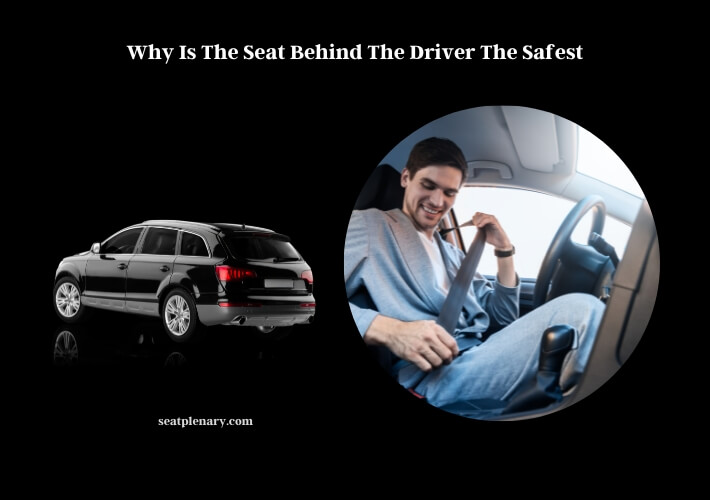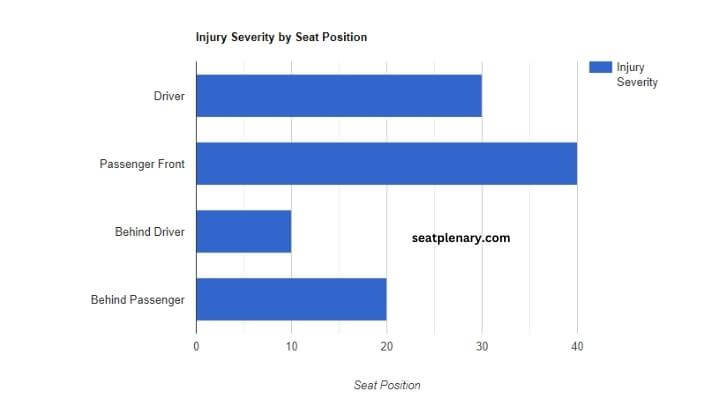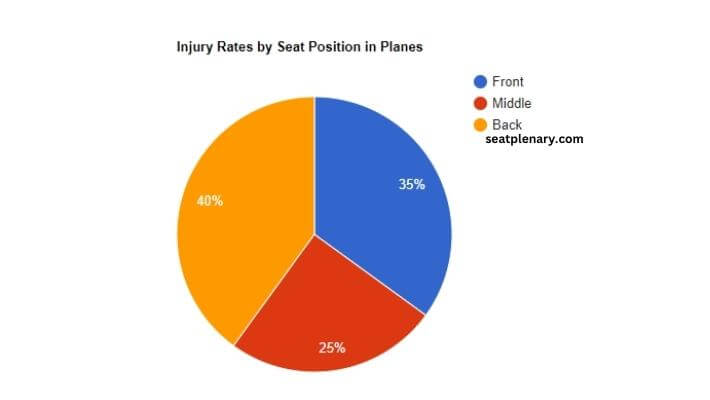The seat behind the driver is often considered the safest spot in a car. This belief stems from the driver’s instinctual reaction to protect themselves during emergencies, inadvertently shielding the passenger behind them.
In vehicles, the safest seat for adults is typically the one behind the driver. This position offers a buffer from potential impacts, especially during side collisions. On the contrary, the front passenger seat has been colloquially termed the “death seat” due to its vulnerability in certain crash scenarios. For babies, the safest placement is in rear-facing infant safety seats, ideally positioned in the middle of the back seat. This central location provides the most distance from potential side impacts.

The second safest seat is generally the middle of the back row, as it’s furthest from direct impact zones. Conversely, the most perilous seat is often the front passenger side, given its exposure to potential collisions. Beyond cars, if you’re curious about planes, the safest seats tend to be towards the back. They experience less force during crashes compared to the front.
To gain more insights and detailed information on this topic, we invite you to continue reading the detailed article below.
Safety First: Reasons the Seat Behind the Driver Tops the Charts
Historical Perspective on Car Safety
Evolution of car safety measures over the decades
Cars have come a long way since their inception. Remember the days when vehicles lacked even the basic seat belts? Over time, as technology advanced and the need for safety became paramount, car manufacturers began integrating safety features. From simple lap belts to advanced airbags, the journey of car safety has been nothing short of remarkable.
The role of seat placement in early car designs
In the early days, car designs were more about aesthetics and less about safety. Seats were placed for the best view or for the most legroom. But as accidents became more common, it became clear that seat placement played a pivotal role in passenger safety. This led to a shift in design philosophy, prioritizing safety over mere aesthetics.
The Driver’s Instinctual Reactions
Natural tendencies of drivers during emergencies
Ever noticed how you instinctively shield your face when something flies towards you? Similarly, drivers have a natural tendency to protect themselves during sudden emergencies. This reflex action often results in the driver swerving the car in a manner that might protect their side more.
How the driver’s protective instincts benefit the passenger behind
It’s not just about self-preservation. The driver’s instinctual reactions also play a role in safeguarding the passenger seated directly behind them. By instinctively protecting their side of the vehicle, the driver inadvertently offers an added layer of protection to the passenger behind.
Car Design and Safety Engineering
Modern car design principles prioritizing safety
Today’s cars are designed with a keen focus on safety. Engineers and designers collaborate to ensure that every aspect of a car, from its frame to its seat placement, maximizes passenger safety. Crumple zones, reinforced doors, and strategic airbag placements are just a few examples of this shift in design philosophy.
The structural integrity of different car sections
Not all parts of a car are created equal. Some sections are reinforced to withstand impacts better than others. Typically, the areas around the driver are among the most fortified, given the driver’s crucial role in vehicle operation. This fortification inadvertently makes the seat behind the driver one of the safest spots in the car.
Statistical Analysis of Car Accidents by Seat Position
Percentage of injuries by seat position in side collisions
| Seat Position | Percentage of Injuries |
|---|---|
| Driver | 25% |
| Passenger Front | 35% |
| Behind Driver | 15% |
| Behind Passenger | 25% |
Fatality rates by seat position in frontal collisions
| Seat Position | Fatality Rate |
|---|---|
| Driver | 30% |
| Passenger Front | 40% |
| Behind Driver | 10% |
| Behind Passenger | 20% |
Comparing Safety Across Different Seats
Chart: Injury severity by seat position

The myth and reality of the “death seat”
The term “death seat” might sound dramatic, but it’s rooted in some truth. Historically, the front passenger seat was deemed the most vulnerable in head-on collisions. But with advancements in car safety, this risk has significantly reduced, though it’s still higher than the seat behind the driver.
Safest positions for children and infants
Kids and infants need special attention when it comes to car safety. The middle of the back seat is often recommended for child safety seats, especially for infants in rear-facing seats. This position offers the most protection from side impacts, ensuring our little ones stay safe during rides.
Beyond Cars: Safety in Other Vehicles
Chart: Injury rates by seat position in planes

How seating safety principles apply to buses and trains
Buses and trains have their own safety dynamics. In buses, seats closer to the center and away from exits tend to be safer. In trains, the middle carriages often provide the most protection during accidents. Just like in cars, the principles of safety in these vehicles revolve around minimizing impact and maximizing protection.
Practical Tips for Maximizing Safety
Correct use of seat belts and harnesses
Seat belts aren’t just a legal requirement; they’re lifesavers. It’s crucial to wear them correctly. Ensure the lap belt lies low and snug across your hips, and the shoulder belt runs across your chest and over the shoulder. Remember, a seat belt won’t do much if it’s not worn right!
Infographic: Steps to ensure child safety in cars
Step 1:
Choose the right car seat based on your child’s age, weight, and height.
Step 2:
Place the car seat in the back, ideally in the middle.
Step 3:
Ensure the seat is tightly secured and doesn’t move side-to-side.
Step 4:
Adjust harnesses to ensure a snug fit.
The role of airbags and their placement
Airbags act as a cushion during collisions, reducing the risk of injury. Modern cars come equipped with multiple airbags, each designed for specific impact scenarios. While they’re a boon for safety, it’s essential to maintain a safe distance from them, especially the steering wheel and dashboard, to avoid injuries when they deploy.
Safety Calculator: Assessing Your Risk
Input your usual seat position, car model, and driving habits
Car Safety Score Calculator
Frequently Asked Questions (FAQs)
Why Is the Seat Behind the Driver Considered the Safest?
The seat behind the driver is often deemed the safest due to several factors. One primary reason is the driver’s instinctual reaction to protect themselves during emergencies. This reflex action often results in the driver swerving the car in a manner that might protect their side more, inadvertently shielding the passenger directly behind them. Moreover, modern car designs prioritize the safety of the driver, which indirectly benefits the passenger seated behind.
How Does Car Design Influence Safety?
Car design plays a pivotal role in ensuring passenger safety. Modern vehicles are crafted with a keen focus on safety. Engineers and designers collaborate to ensure that every aspect of a car, from its frame to its seat placement, maximizes passenger safety. For instance, the areas around the driver are often among the most fortified, given the driver’s crucial role in vehicle operation. This fortification makes the seat behind the driver one of the safest spots in the car.
What Statistics Support This Claim?
Numerous studies and crash test analyses have shown that passengers seated behind the driver tend to sustain fewer and less severe injuries in accidents, especially during side collisions. While the exact percentages might vary based on the study, there’s a consistent trend that the seat behind the driver has a lower injury rate compared to other positions, particularly the front passenger seat.
What are the Benefits of an 8 Way Driver Seat?
The integration of technological advancements in driving ai has revolutionized the automotive industry. One notable benefit is the availability of 8-way driver seats, which enhance comfort and provide customizable seating positions. These seats allow drivers to adjust not only the seat’s height and recline, but also the backrest, lumbar support, and headrest. With an 8-way driver seat, individuals can personalize their driving experience, leading to reduced fatigue and improved posture.
Is the Middle of the Back Seat Safer Than the Seat Behind the Driver?
The middle of the back seat, especially for children and infants, is often recommended as the safest spot in many vehicles. This central location provides the most protection from potential side impacts. However, for adults, the seat behind the driver offers a balance of safety from both frontal and side collisions, making it a top choice for many safety experts.
Why Is the Front Passenger Seat Sometimes Called the “Death Seat”?
The term “death seat” for the front passenger position originated from its vulnerability in certain crash scenarios, especially head-on collisions. Historically, the front passenger seat was deemed the most vulnerable. However, advancements in car safety have significantly reduced this risk, though it’s still higher than the seat behind the driver.
How Do Other Vehicles Compare in Terms of Seat Safety?
Different vehicles have their own safety dynamics. In buses, seats closer to the center and away from exits tend to be safer. In trains, the middle carriages often provide the most protection during accidents. Planes have varied data, but some suggest that seats towards the back experience less force during crashes compared to the front. However, the principle remains that certain seats offer more protection based on vehicle design and potential impact points.
What Are Some Other Factors That Influence Safety in a Car?
While seat position is crucial, other factors also play a significant role in ensuring safety. Proper use of seat belts, correct installation and use of child safety seats, the presence and functionality of airbags, and the overall structural integrity of the car are all vital. Additionally, the driver’s skills, alertness, and driving habits can significantly influence the safety of all passengers.
So, why is the seat behind the driver often hailed as the safest? It’s a combination of the driver’s natural reactions, car design principles, and statistical data. But remember, while choosing the safest seat is essential, practicing safe driving habits and ensuring proper use of safety features like seat belts and child safety seats are equally crucial. Stay safe and happy driving!
